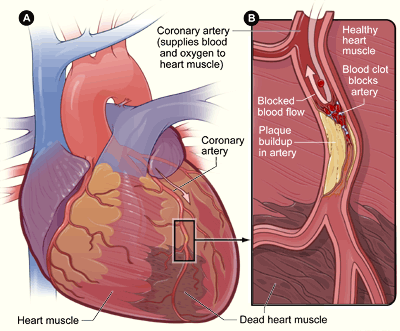

A heart attack, also known as a myocardial infarction, occurs when the flow of blood to a part of the heart is blocked or reduced, causing damage to the heart muscle. This is usually due to a blockage in one or more coronary arteries, often caused by a buildup of plaque. If the blockage isn’t resolved quickly, heart muscle tissue may die from lack of oxygen, leading to potentially severe and life-threatening complications.
A heart attack, also known as a myocardial infarction, occurs when the flow of oxygen-rich blood to a section of heart muscle suddenly becomes blocked and the heart can’t get oxygen. If blood flow isn’t restored quickly, the section of heart muscle begins to die.
Causes
Heart attacks are most often caused by coronary artery disease (CAD), a condition characterized by atherosclerosis (plaque buildup) in the coronary arteries. Plaque can rupture, forming a blood clot that blocks blood flow. Other, less common causes include:- Coronary artery spasm: Sudden tightening or spasm of a coronary artery.
- Coronary artery dissection: A tear in the coronary artery wall.
- Blood clotting disorders: Certain conditions can increase the risk of blood clots.
- A complete blockage caused by a blood clot forming on top of a plaque rupture.
- A spasm of a coronary artery that shuts down blood flow to part of the heart muscle.
- Extremely low blood pressure (shock) that decreases blood flow to the heart.
Risk Factors
Several factors increase the risk of a heart attack:- Smoking
- High blood pressure
- High cholesterol
- Diabetes
- Obesity
- Sedentary lifestyle
- Family history of heart disease
- Age (higher risk for men over 45 and women over 55)
- Stress
- Heavy alcohol use
- Age (risk increases for men after age 45 and for women after age 55)
- Tobacco (smoking or long-term exposure to secondhand smoke)
- High blood pressure
- High cholesterol or triglyceride levels
- Obesity
- Diabetes
- Metabolic syndrome
- Family history of heart attack
- Lack of physical activity
- Stress
- Illicit drug use, such as cocaine or amphetamines
- A history of preeclampsia during pregnancy
Symptoms
Symptoms of a heart attack can vary, but common signs include:- Chest pain or discomfort, often described as pressure, squeezing, or fullness
- Pain or discomfort in the arms, back, neck, jaw, or stomach
- Shortness of breath
- Nausea, vomiting, or indigestion
- Lightheadedness or dizziness
- Breaking out in a cold sweat
- Fatigue
- Anxiety or a feeling of impending doom
- Chest pain or discomfort that may last more than a few minutes or that goes away and comes back. It can feel like pressure, squeezing, fullness, or pain.
- Shortness of breath, which may occur with or before chest discomfort.
- Other areas of upper body discomfort, such as pain or discomfort in one or both arms, the back, neck, jaw, or stomach.
- Other symptoms can include breaking out in a cold sweat, nausea, or lightheadedness.
Diagnosis
Diagnosing a heart attack involves evaluating symptoms and using diagnostic tests, such as:- Electrocardiogram (ECG/EKG): Detects abnormal heart rhythms and signs of heart muscle damage.
- Blood tests: Measure cardiac biomarkers, such as troponin, which indicate heart muscle damage.
- Imaging: Echocardiogram, chest X-ray, or cardiac catheterization to assess heart function and identify blockages.
- Electrocardiogram (ECG or EKG): This is the first test done to diagnose a heart attack. It measures the heart’s electrical activity.
- Blood tests: Certain heart enzymes slowly leak out into your blood if your heart has been damaged by a heart attack. Tests will measure the levels of these enzymes.
Treatment
Treatment for a heart attack focuses on restoring blood flow to the heart and preventing further damage:- Medications: Thrombolytics (clot-busting drugs), anticoagulants (blood thinners), antiplatelet agents (e.g., aspirin), and medications to reduce heart workload (e.g., beta-blockers, ACE inhibitors).
- Medical procedures: Angioplasty with stent placement to open blocked arteries, or coronary artery bypass grafting (CABG) for severe cases.
- Supportive care: Oxygen therapy and pain management.
- Emergency treatment: Aspirin to reduce blood clotting; nitroglycerin to relieve chest pain and improve blood flow; and oxygen therapy.
- Medications: Thrombolytics (clot busters) to dissolve the blood clot; antiplatelet agents to prevent new clots and keep existing clots from getting bigger; anticoagulants to thin blood; and pain relievers.
- Surgical and other procedures: Coronary angioplasty and stenting to open blocked arteries; coronary artery bypass grafting (CABG) to restore blood flow to the heart.
Prevention
Preventing a heart attack involves managing risk factors and leading a heart-healthy lifestyle. This includes eating a balanced diet, exercising regularly, quitting smoking, controlling conditions such as high blood pressure, high cholesterol, and diabetes, and maintaining a healthy weight.Aftercare and Rehabilitation
After a heart attack, cardiac rehabilitation is often recommended to help patients recover and reduce the risk of future heart problems. This may include:- Exercise programs to improve cardiovascular health
- Education about heart-healthy living and lifestyle changes
- Counseling and support for managing stress and emotional health
- Medication management to control risk factors like high blood pressure and cholesterol
